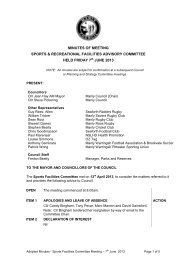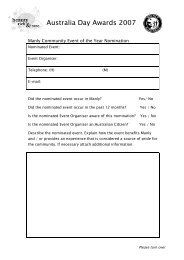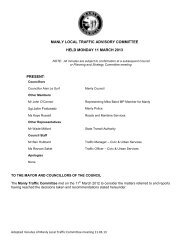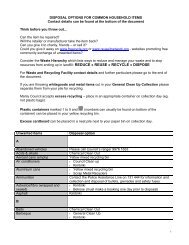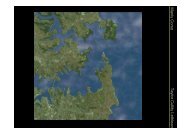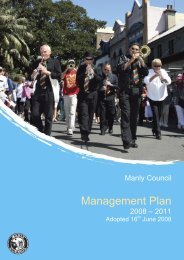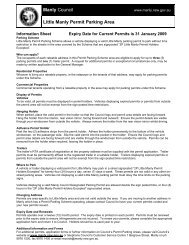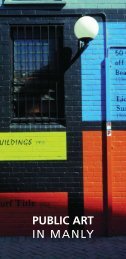Manly Lagoon Dredging Project - Manly Council - NSW Government
Manly Lagoon Dredging Project - Manly Council - NSW Government
Manly Lagoon Dredging Project - Manly Council - NSW Government
- No tags were found...
You also want an ePaper? Increase the reach of your titles
YUMPU automatically turns print PDFs into web optimized ePapers that Google loves.
<strong>Manly</strong> <strong>Lagoon</strong> <strong>Dredging</strong> <strong>Project</strong> – Review of Environmental FactorsPrepared for <strong>Manly</strong> and Warringah <strong>Council</strong>sCormorants present at this site; however no protected adult birds, other than the Little PiedCormorant sitting, were present during field observations on 12 November 2009. The nestwas also in a Casuarina, which extends out over the <strong>Lagoon</strong> (Figure 5.11). For full details offield observations at this site see Appendix L.Balodis and Guyatt (2003) conducted a waterbird survey of the <strong>Manly</strong> <strong>Lagoon</strong> catchment aspart of the UTS Freshwater Ecology Report 2003 (UTS, 2003), which indicated that the LittlePied Cormorant species was present in 2003 in <strong>Manly</strong> <strong>Lagoon</strong> and inhabited the <strong>Manly</strong><strong>Lagoon</strong> site with reasonable consistency. Balodis and Guyatt (2003) also note in theirwaterbird survey that some species appeared to have distinct territories or roosting spots atsome sites within the catchment, including the Little Pied Cormorant at <strong>Manly</strong> <strong>Lagoon</strong>.According to the Field Guide to Australian Birds (Morcombe, 2003) the Little Pied Cormorant(Phalacrocorax melanoleucos) typically breeds in colonies (usually not very large colonies)and their nests are typically in trees overhanging water bodies such as lakes and rivers.According to Australian Birds Their Nests and Eggs (Beruldsen, 2003) the nesting seasonfor Little Pied Cormorants usually takes place in Sydney in the spring and early summer i.e.September to December, with a breeding frequency of probably once each year.Little Pied Cormorants sit on their eggs for approximately 30 days before they hatch. Oncethe eggs hatch the chicks require feeding by their parents until they are ready to fly and feedthemselves at approximately seven weeks of age (Australian Museum, 2009).Migratory SpeciesThe search of the EPBC Database also identified 33 migratory species listed as matters ofnational environmental significance. These migratory species and their type of presence inthe area are listed in Table 5.10.2 July 2010 Cardno (<strong>NSW</strong>/ACT) Pty Ltd 88H:\Doc\2010\Reports.2010\Rep2580v4.doc



